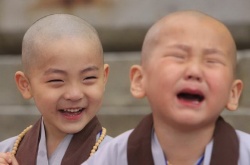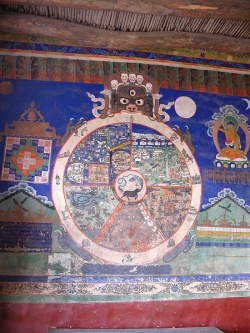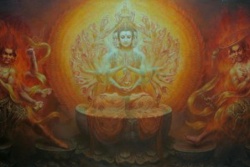Difference between revisions of "Tonpa Shenrab Miwoche"
| (20 intermediate revisions by 4 users not shown) | |||
| Line 1: | Line 1: | ||
[[File:Babymonk1.jpg|thumb|250px|]] | [[File:Babymonk1.jpg|thumb|250px|]] | ||
| + | |||
| + | |||
| + | |||
| + | |||
| + | |||
| + | [[Tönpa Shenrab]] ([[Tibetan]]: [[ston pa gshen rab]]) or [[Shenrab Miwo]] ([[Tibetan]]: [[gshen rab mi bo]])—also called [[Buddha Shenrab]], [[Guru Shenrab]], [[Tönpa Shenrab Miwoche]], [[Lord Shenrab Miwo]], and known by a number of other titles—is the founder of the [[Bön]] [[religious]] [[tradition]] of {{Wiki|Tibet}}. | ||
| + | |||
| + | |||
| + | |||
| + | "[[gShen-rab mi-bo]] is the founder of the [[Bön]] [[Religion]]. | ||
| + | |||
| + | He occupies a position very similar to that of [[Śākyamuni]] in [[Buddhism]], but in contrast to the [[Lord]] [[Buddha]], we have no available sources with which to establish his historicity, his dates, his racial origin, | ||
| + | |||
| + | his [[activities]], and the authenticity of the enormous number of [[Books]] either attributed directly to him or believed to be his [[word]]. | ||
| + | |||
| + | The [[latter]], the [[Bonpo]] say, were written down after his [[Death]] in much the same way as the [[Buddhist scriptures]] were assembled. | ||
| + | |||
| + | It is only from later sources in which fact and legend are woven together that we can get any [[idea]] of his [[Life]]. | ||
| + | |||
| + | No pre-10th century materials are so far available that might throw [[Light]] on [[activities]] such as his visit to [[Tibet]]...." <ref>[[Karmey]], [[Samten]] G. (1975). | ||
| + | |||
| + | A General Introduction to the History and [[Doctrines]] of [[Bon]], pp. 175-176. Memoirs of the Research Department of the [[Toyo Bunko]], No. 33. {{Wiki|Tokyo}}.</ref> | ||
| + | |||
| + | |||
| + | |||
| + | ===[[Shenrab's Life]] according to [[Bön traditions]]=== | ||
| + | |||
| + | |||
| + | |||
| + | According to [[Bön tradition]], [[Tönpa Shenrab]] predates [[Padmasambhava]] and The [[Buddha Śākyamuni]]. | ||
| + | |||
| + | It is held that [[Tönpa Shenrab]] first studied the [[Bön Doctrine]] in [[Tagzig Olmo Lung Ring]] (which for {{Wiki|economy}} may be equated with [[space]], | ||
| + | |||
| + | [[Heaven]] and the [[aetherial realm]]), at the end of which he pledged to [[Shenlha Ökar]] ([[Tibetan]]: | ||
| + | |||
| + | [[gshen lha 'od dkar]]), the [[God of Compassion]], that he would guide the peoples of this [[World]] to [[Liberation]]. Like The [[Buddha]] [[Śākyamuni]], [[Tönpa Shenrab]] was of {{Wiki|royal}} [[birth]]. | ||
| + | |||
| + | [[Tönpa Shenrab]] renounced his {{Wiki|royal}} inheritance at the age of thirty-one to travel the [[path to Enlightenment]]. | ||
| + | |||
| + | [[Tönpa Shenrab]] embraced the [[Life]] of a renunciate and commenced austerities, spreading the [[Doctrine of Bön]]; at length, he arrived in the land of [[Zhangzhung]] near what is widely held to be [[Mt Kailash]]. | ||
| + | |||
| + | |||
| + | Accounts of [[Tönpa Shenrab's Life]] are to be found in three [[principal]] sources, entitled; | ||
| + | |||
<poem> | <poem> | ||
| − | + | [[Do-dü]] ([[mdo 'dus]]), | |
| + | [[Zer-mik]] ([[gzer mig]]), and [ | ||
| + | [[Zee-jee]] ([[gzi brjid]]). | ||
| + | </poem> | ||
| − | |||
| − | |||
| − | + | The first and second of the accounts are held to be [[Terma]] ([[gter ma]]) discovered by [[Bön]] [[Tertön]] ([[gter ston]]) in the tenth or eleventh century; the third is part of the "[[aural lineage]]"([[nyen jü]], [[snyan brgyud]]), transmitted via disciplic succession. | |
| + | |||
| + | |||
| + | |||
| + | ===The [[Four Portals]] and the Fifth, the [[Treasury]]=== | ||
| + | |||
| + | |||
| + | |||
| + | The [[doctrines]] [[taught]] by [[Tönpa Shenrab]] are generally classified variously, two [[being]] most common. In the first, The [[Four Portals]] and the Fifth, the [[Treasury]] ([[sgo bzhi mdzod lnga]]), the: | ||
| − | |||
| − | |||
| − | |||
[[File:Bhavacakra Thikse.jpg|thumb|250px|]] | [[File:Bhavacakra Thikse.jpg|thumb|250px|]] | ||
| − | + | * [[White Water]] ([[chab dkar]]) relates [[esoteric]] matters; | |
| − | + | * [[Black Water]] ([[chab nag]]) concerns [[Wikipedia:narrative|narratives]], [[magic]], [[funeral]] [[rites]] and ransom [[rituals]]; | |
| − | + | * [[Land of Phan]] ([[phan yul]]) codifies [[monastic rules]] and [[philosophical]] [[expositions]]; | |
| − | + | * [[Divine Guide]] ([[dpon gsas]]) enshrines the [[Dzogchen teachings]]; and finally | |
| − | + | * [[Treasury]] ([[mtho thog]]) which serves as an {{Wiki|anthology}} of the salient items of the [[Four Portals]]. | |
| + | |||
| − | |||
| − | The second classification, the Nine Ways of Bön (bon theg pa rim dgu) is as follows—the: | + | ===The [[Nine Ways of Bön]]=== |
| + | |||
| + | |||
| + | |||
| + | The second {{Wiki|classification}}, the [[Nine Ways of Bön]] ([[bon theg pa rim dgu]]) is as follows—the: | ||
| + | |||
| + | |||
| + | # [[Way of Prediction]] ([[phyva gshen theg pa]]) codifies [[ritual]], {{Wiki|prognostication}}, sortilege and [[Astrology]]; | ||
| + | # [[Way of the Visual World]] ([[snang shen theg pa]]) details the [[psychophysical]] [[Universe]]; | ||
| + | |||
| + | # [[Way of Illusion]] ([[phrul gshen theg pa]]) explains the [[rites]] for the dispersal of adverse [[thoughtforms]], entities and energies; | ||
| + | # [[Way of Existence]] ([[srid gshen theg pa]]) details [[funeral]] and [[Death rituals]]; | ||
| + | |||
| + | # [[Way of a Lay Follower]] ([[dge bsnyen theg pa]]) contains the ten {{Wiki|principles}} for [[wholesome]] [[activity]]; | ||
| + | # [[Way of a Monk]] ([[drang srong theg pa]]) codifies [[monastic rules]] and regulations; | ||
| + | |||
| + | # [[Way of Primordial Sound]] ([[a dkar theg pa]]) charts the {{Wiki|integration}} of an [[exalted]] [[practitioner]] into the [[Mandala of highest Enlightenment]]; | ||
| + | |||
| + | |||
| + | # [[Way of Primordial Shen]], ([[ye gshen theg pa]]) renders the guidelines for seeking a true [[tantric master]] and the [[commitments]] ([[dam tshigs]], parallel to the [[Sanskrit]] [[Samaya]]) that bind a [[Disciple]] to his [[tantric master]]; and finally, | ||
| + | |||
| + | # [[Way of Supreme Natural Condition]] ([[bla med theg pa]]), or The [[Way of Dzogchen]]. | ||
| + | |||
| + | |||
| + | The [[nine ways]] can also be classified into [[three groups]], the: | ||
| − | |||
| − | |||
| − | |||
| − | |||
| − | |||
| − | |||
| − | |||
| − | |||
| − | |||
| − | |||
[[File:Bodhisat.jpg|thumb|250px|]] | [[File:Bodhisat.jpg|thumb|250px|]] | ||
| − | + | # [[Causal Ways]] ([[rgyu'i theg pa]]) comprises the first four of the above; | |
| − | + | # [[Resultant Ways]] ([[bras bu'i theg pa]]) includes the fifth through eighth; and | |
| − | + | # [[Unsurpassable Way]] or the Way of [[Dzogchen]] ([[khyad par chen po'i theg pa]] or [[rdzogs pa chen po]], abbreviated [[rdzogs chen]]) is the ninth. | |
| + | |||
| + | |||
| + | |||
| + | ===The [[Bön Canon]]=== | ||
| + | |||
| + | |||
| + | |||
| + | The [[Bön canon]] comprises more than two hundred volumes, classified in four categories: the [[Sutras]] ([[mdo]]), the [[Perfection of Wisdom Teachings]] ([[bum]]), the [[Tantras]] ([[rgyud]]) and [[Knowledge]] ([[mdzod]]). | ||
| + | |||
| + | Besides these, the [[Bön canon]] includes material on [[rituals]], [[arts]] and crafts, [[logic]], [[medicine]], [[poetry]] and {{Wiki|narrative}}. | ||
| − | + | It is [[interesting]] to note that the "[[Knowledge]]" section concerning {{Wiki|cosmogony}} and [[cosmology]], though in some respects unique to [[Bön]], shares a more than passing resemblance to [[Nyingma]] ([[rnying ma]]) [[doctrines]]. | |
| − | |||
| − | |||
| − | |||
| − | |||
| − | + | ===Aspects of [[Shenrab Miwoche]]=== | |
| + | |||
| + | |||
| + | |||
| + | [[Shenrab Miwoche]] is said to have three aspects or [[forms]]: | ||
| + | |||
| + | |||
| + | <poem> | ||
| + | the [[Tulku]] ([[Tibetan]]: | ||
| + | [[sprul sku]]; [[Sanskrit]]: | ||
| + | [[Nirmaṇakāya]]), [[Shenrab Miwoche]]; | ||
</poem> | </poem> | ||
| + | |||
| + | |||
| + | the [[dzoku]] ([[Tibetan]]: [[rdzogs sku]]; [[Sanskrit]]: [[Sambhogakāya]]), [[Shenlha Ökar]]; and the [[bönku]] ([[Tibetan]]: | ||
| + | |||
| + | [[bon sku]]; [[Sanskrit]]: [[Dharmakāya]]), [[Kuntu Zangpo]].<ref> | ||
| + | |||
| + | The [[Tibetan]] for [[dharmakāya]] is [[chos sku]] in the [[Buddhist]] context; | ||
| + | |||
| + | |||
| + | though a case can be made that [[Bön]] borrowed some, or even much, of its current {{Wiki|terminology}} from [[Buddhism]], to suggest that [[Sanskrit]] words are thus the "source" of this {{Wiki|terminology}} is dubious.</ref> | ||
| + | |||
| + | |||
| + | ==References== | ||
| + | * Unknown Author (2005). The [[Bonpo's Tradition]]. Source: http://www.tibet.net/cta/bonpo.html ([[Wednesday]] January 17, 2007). | ||
| + | |||
| + | {{reflist}} | ||
| + | |||
{{R}} | {{R}} | ||
[http://everything.explained.at/Tonpa_Shenrab_Miwoche/ everything.explained.at] | [http://everything.explained.at/Tonpa_Shenrab_Miwoche/ everything.explained.at] | ||
| − | + | ||
| − | [[Category: | + | |
| + | [[Category:Tonpa Shenrap Miwoche]] | ||
Latest revision as of 07:02, 11 December 2015
Tönpa Shenrab (Tibetan: ston pa gshen rab) or Shenrab Miwo (Tibetan: gshen rab mi bo)—also called Buddha Shenrab, Guru Shenrab, Tönpa Shenrab Miwoche, Lord Shenrab Miwo, and known by a number of other titles—is the founder of the Bön religious tradition of Tibet.
"gShen-rab mi-bo is the founder of the Bön Religion.
He occupies a position very similar to that of Śākyamuni in Buddhism, but in contrast to the Lord Buddha, we have no available sources with which to establish his historicity, his dates, his racial origin,
his activities, and the authenticity of the enormous number of Books either attributed directly to him or believed to be his word.
The latter, the Bonpo say, were written down after his Death in much the same way as the Buddhist scriptures were assembled.
It is only from later sources in which fact and legend are woven together that we can get any idea of his Life.
No pre-10th century materials are so far available that might throw Light on activities such as his visit to Tibet...." [1]
Shenrab's Life according to Bön traditions
According to Bön tradition, Tönpa Shenrab predates Padmasambhava and The Buddha Śākyamuni.
It is held that Tönpa Shenrab first studied the Bön Doctrine in Tagzig Olmo Lung Ring (which for economy may be equated with space,
Heaven and the aetherial realm), at the end of which he pledged to Shenlha Ökar (Tibetan:
gshen lha 'od dkar), the God of Compassion, that he would guide the peoples of this World to Liberation. Like The Buddha Śākyamuni, Tönpa Shenrab was of royal birth.
Tönpa Shenrab renounced his royal inheritance at the age of thirty-one to travel the path to Enlightenment.
Tönpa Shenrab embraced the Life of a renunciate and commenced austerities, spreading the Doctrine of Bön; at length, he arrived in the land of Zhangzhung near what is widely held to be Mt Kailash.
Accounts of Tönpa Shenrab's Life are to be found in three principal sources, entitled;
The first and second of the accounts are held to be Terma (gter ma) discovered by Bön Tertön (gter ston) in the tenth or eleventh century; the third is part of the "aural lineage"(nyen jü, snyan brgyud), transmitted via disciplic succession.
The Four Portals and the Fifth, the Treasury
The doctrines taught by Tönpa Shenrab are generally classified variously, two being most common. In the first, The Four Portals and the Fifth, the Treasury (sgo bzhi mdzod lnga), the:
- White Water (chab dkar) relates esoteric matters;
- Black Water (chab nag) concerns narratives, magic, funeral rites and ransom rituals;
- Land of Phan (phan yul) codifies monastic rules and philosophical expositions;
- Divine Guide (dpon gsas) enshrines the Dzogchen teachings; and finally
- Treasury (mtho thog) which serves as an anthology of the salient items of the Four Portals.
The Nine Ways of Bön
The second classification, the Nine Ways of Bön (bon theg pa rim dgu) is as follows—the:
- Way of Prediction (phyva gshen theg pa) codifies ritual, prognostication, sortilege and Astrology;
- Way of the Visual World (snang shen theg pa) details the psychophysical Universe;
- Way of Illusion (phrul gshen theg pa) explains the rites for the dispersal of adverse thoughtforms, entities and energies;
- Way of Existence (srid gshen theg pa) details funeral and Death rituals;
- Way of a Lay Follower (dge bsnyen theg pa) contains the ten principles for wholesome activity;
- Way of a Monk (drang srong theg pa) codifies monastic rules and regulations;
- Way of Primordial Sound (a dkar theg pa) charts the integration of an exalted practitioner into the Mandala of highest Enlightenment;
- Way of Primordial Shen, (ye gshen theg pa) renders the guidelines for seeking a true tantric master and the commitments (dam tshigs, parallel to the Sanskrit Samaya) that bind a Disciple to his tantric master; and finally,
The nine ways can also be classified into three groups, the:
- Causal Ways (rgyu'i theg pa) comprises the first four of the above;
- Resultant Ways (bras bu'i theg pa) includes the fifth through eighth; and
- Unsurpassable Way or the Way of Dzogchen (khyad par chen po'i theg pa or rdzogs pa chen po, abbreviated rdzogs chen) is the ninth.
The Bön Canon
The Bön canon comprises more than two hundred volumes, classified in four categories: the Sutras (mdo), the Perfection of Wisdom Teachings (bum), the Tantras (rgyud) and Knowledge (mdzod).
Besides these, the Bön canon includes material on rituals, arts and crafts, logic, medicine, poetry and narrative.
It is interesting to note that the "Knowledge" section concerning cosmogony and cosmology, though in some respects unique to Bön, shares a more than passing resemblance to Nyingma (rnying ma) doctrines.
Aspects of Shenrab Miwoche
Shenrab Miwoche is said to have three aspects or forms:
the Tulku (Tibetan:
sprul sku; Sanskrit:
Nirmaṇakāya), Shenrab Miwoche;
the dzoku (Tibetan: rdzogs sku; Sanskrit: Sambhogakāya), Shenlha Ökar; and the bönku (Tibetan:
bon sku; Sanskrit: Dharmakāya), Kuntu Zangpo.[2]
References
- Unknown Author (2005). The Bonpo's Tradition. Source: http://www.tibet.net/cta/bonpo.html (Wednesday January 17, 2007).
Footnotes
- ↑ Karmey, Samten G. (1975). A General Introduction to the History and Doctrines of Bon, pp. 175-176. Memoirs of the Research Department of the Toyo Bunko, No. 33. Tokyo.
- ↑ The Tibetan for dharmakāya is chos sku in the Buddhist context; though a case can be made that Bön borrowed some, or even much, of its current terminology from Buddhism, to suggest that Sanskrit words are thus the "source" of this terminology is dubious.


